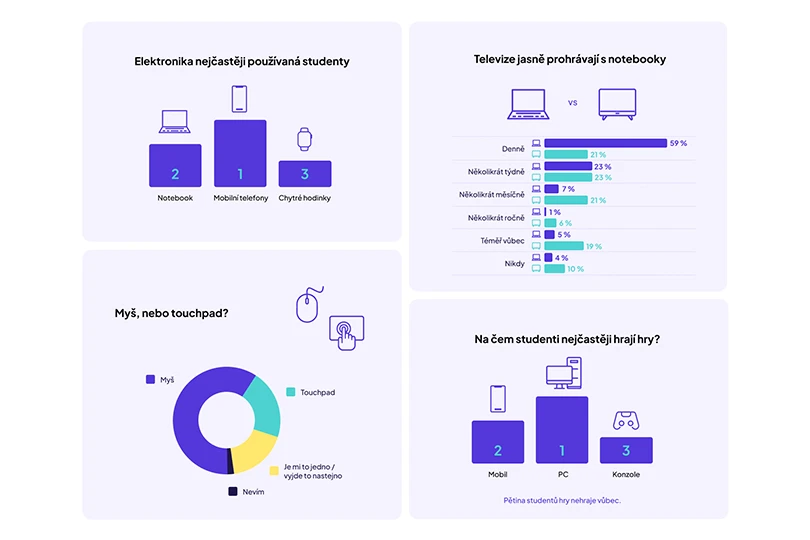More than a third of students practically don’t watch television. Only one fifth watch it every day, and another fifth watch it several times a week. On the other hand, the mobile phone is by far the most popular electronic device among students, with practically every student using it daily. Right behind it is the laptop, used daily by six out of ten students. Smartwatches took third place among electronic devices. This emerged from a survey of a thousand students aged 16 to 25, conducted in January 2024 by GTS Alive, which among other things issues and manages ISIC student cards.
The mentioned smartwatches are interesting because their fans and opponents—or those who ignore them—are practically split evenly. Forty percent of students use smartwatches daily, while 42 percent never use them.
Desktop computers still play a role among students; a quarter use them daily, which is more than tablets. Tablets are losing their position, as most young people use them only occasionally or not at all. Three-quarters of students have not gotten into gaming consoles and practically do not use them. More than a tenth, however, play on them daily or several times a week. Mobile gaming is more popular, and the most popular platform is the computer. However, one fifth of students do not play games at all.
Only about one in ten students regularly uses an e-book reader. Even less popular so far are virtual reality glasses, actively used by about eight percent of students. Conversely, 83 percent of students have never tried them.
Students very often use electronic devices for school-related work—specifically, 83 percent of students, with another 13 percent doing so quite often. When working with a laptop, 60 percent of young people prefer using a mouse over a touchpad, 20 percent prefer the touchpad, and the rest do not care.
In electronics stores, including e-shops, students most often buy various accessories and phones, followed by laptops, IT equipment, and smart products. They usually choose a specific store or e-shop based on price but also value other services such as quick exchanges, hassle-free returns, or free delivery. Two-thirds of students buy electronics more often in e-shops than in physical stores.
The survey was conducted online in January 2024 among a thousand secondary and university students in the Czech Republic aged 16 to 25.
How often do Czech students aged 16 to 25 use various electronic devices?
| Daily | Several times a week | Several times a month | Several times a year | Hardly ever | Never | |
| Mobile phone | 99,4 % | 0,2 % | 0,0 % | 0,0 % | 0,4 % | 0,0 % |
| Laptop | 58,9 % | 23,2 % | 7,4 % | 1,4 % | 4,7 % | 4,5 % |
| Smartwatch | 40,0 % | 5,8 % | 2,8 % | 2,6 % | 6,9 % | 41,8 % |
| Desktop computer | 23,8 % | 14,0 % | 10,5 % | 5,4 % | 17,0 % | 29,3 % |
| Tablet | 22,2 % | 10,5 % | 7,6 % | 5,0 % | 12,8 % | 41,9 % |
| Television | 21,3 % | 23,1 % | 20,9 % | 5,7 % | 18,8 % | 10,2 % |
| Fitness band | 14,3 % | 3,2 % | 1,7 % | 1,6 % | 8,2 % | 70,9 % |
| Gaming console | 3,4 % | 8,4 % | 12,9 % | 10,0 % | 16,2 % | 49,0 % |
| Ebook reader | 2,8 % | 3,7 % | 4,9 % | 5,5 % | 5,9 % | 77,2 % |
| Virtual reality glasses | 0,3 % | 0,8 % | 2,4 % | 5,5 % | 8,1 % | 82,9 % |
Students and electronics in 2024

For more information, contact:
Jan Šimral, media representative of GTS Alive
Tel.: +420 737 944 370
E-mail: info@jansimral.com






